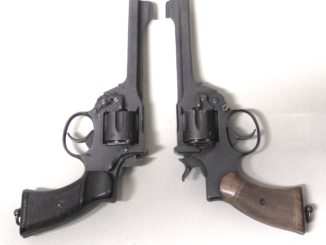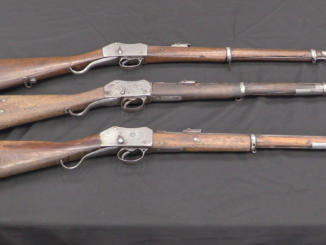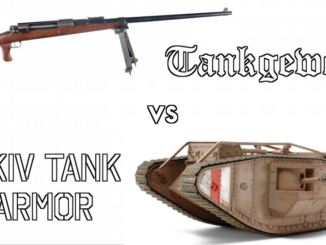Armament Research Services (ARES) is a specialist technical intelligence consultancy, offering expertise and analysis to a range of government and non-government entities in the arms and munitions field. For detailed photos of the guns in this video, don’t miss the ARES companion blog post!
One of the original design intentions of the SA80 project was to replace the infantry rifle and the submachine gun with a single weapon that could fulfill both roles – hence the choice of a bullpup configuration. This would, theoretically, allow rifle ballistics and also SMG handling and maneuverability. As with most bullpup projects, however, this plan did not last. It quickly became clear that a shortened version of the L85 rifle could be made, which would be more suitable for troops who would previously have been issued submachine guns – notably aircraft and armored vehicle crews.
Today we take a look at a couple early prototypes of these carbines which did not go into production. We also examine an L22A2 carbine, which did become standard issue in 2003 for some units. This carbine includes all of the H&K A2 pattern upgrades, and was given the A2 designation despite there never being an adopted L22A1.




They could have saved themselves a lot of time, trouble, and expense by simply putting a short plastic stock on the Bushmaster arm gun;
https://en.wikipedia.org/wiki/Bushmaster_Arm_Pistol
Which also had the advantage of being completely ambidextrous with no rearrangement of the machinery required.
Incidentally, I’d expect firing this little bugger from the shoulder would give you “Tavor face” in nothing flat.
cheers
eon
“They could have saved themselves a lot of time, trouble, and expense by simply putting a short plastic stock on the Bushmaster arm gun;”
Yes, but that would add next weapon to service, with its own spare parts, which would defy purpose of NOT having totaling different sub-machine gun from rifle.
Sometimes, I am amazed by eon’s speed to comment as soon as a video is published….
That’s because it’s Neo. Or Eon. Backwards or forwards. The Matrix works like that….
Is its E-ON or E-AN (Ian)? Coincidence? Hardly!
Nope, I’m not Ian, he’s way smarter than me.
😉
cheers
eon
And it’s always interesting. Thank you.
Thank you.
cheers
eon
Ian touched on “custom parts” in the gas system
Were there changes needed to the port sizes, volumes and exhaust hole positions of the gas system, in order to allow reliable operation with the port being closer to both the breech and the muzzle?
I’d imagine there would have to be. Even gases are subject to friction when moving through a tube, plus there would be some cooling effect with travel and dwell time, even though we’re talking microseconds. Meaning, shorter tube, higher pressure than the system was originally balanced for. Resulting in greater bolt velocity in recoil.
This situation was one reason the XM177 variant of the M16 always had a higher cyclic rate than the full-grown rifle, even with a heavier buffer. (M16 cyclic averaged 750 R/M, XM177 was supposed to be 800 but was actually more like 850-900 depending on ambient air temp.)
I’d expect the L22A2, etc. to also have a higher cyclic rate, even with measures to reduce the pressure, like a larger diameter gas port and exhaust port.
cheers
eon
How much does having the H&K logo on it, add to the cost of the pound shop plastic paint brush handle that’s stuck on the front?
Grrrrr! I’m not an H&K fan.
After the G36/XM-8 debacle’, I don’t think H&K has too many fans left, period.
They lost me with the G11. I still like the G3, though.
cheers
eon
To all fairness, they were not entirely to blame. It was Army’s decision not to proceed with procurement. My own question is in what direction they want to move in near future. So far I have seen this ‘rationalized’ 416, which adds some more sense into manufacturing, but concept-wise it is same thing.
http://www.heckler-koch.com/en/products/military/assault-rifles.html
“My own question is in what direction they want to move in near future.”
What do you think about theirs MG4:
http://modernfirearms.net/machine/de/hk-mg-4-e.html
?
Oh yes, when comes to G3 and derivatives, my admiration endures. They made marked commercial success with them too.
Yes, the G3 was a truly global battle rifle, Denny. With many virtues too, I have to admit. But I still prefer the FAL, in part for sentimental and aesthetical reasons but also because I liked it better when I actually handled and fired one.
Imagine, how ‘pure British’ squaddies feel about it. But chances are that many of them are of Asian ethnicity; just looking at recent pictures from Manchester, leads me to that thought. And some of them (police response unit I guess) carried G36 carbines, btw.
Are you having a laugh, in terms of demographics “Asian” people make up less than 10% of the population and for that matter are under represented in the armed forces (the majority serving are Sikh incidentally).
Also no police forces employ the L85 (MOD police used to but switched to a mix of MP7 and C7 carbines).
Back on topic; I’ve always understood that the L22 carbines were produced from actual L86 LSW (there wasn’t a huge stock of receivers in a warehouse to convert) that were originally issued to cadet units. Yes youth groups were issued fully automatic weapons (and are still issued semi automatic ones now; the old straight pull rifles being replaced by semi automatic ones).
Short barreled rifles in 5.56×45 caliber are extra challenge to designers. First thing to consider: where you put the gas tap? If too close to chamber, pressure is too high and response too quick and harsh. If you put it too close to muzzle you do not have enough pressure duration to cycle the action (have seen attempt which failed).
One way out may be Krinkov type device which postpones pressure duration and also improves muzzle blast. I wonder why it was not used on this weapon; it is generic and they were used some time before. Although, it must be said that some current versions of AR15 type carbines come with insanely short barrels – and they work. Well, somehow.
“where you put the gas tap?”
Rather: does it have to be gas-operated? Why not lever-delayed (as kulspruta m/1914) or short-recoil/rotation? But if, for some reason, it must be gas-operated then it is possible to use expansion chamber as in AO-46:
http://guns.wikia.com/wiki/AO-46
Long-recoil operated might be viable aswell for delivering limited RateOfFire and thus better controllability.
“Short barreled rifles in 5.56×45 caliber are extra challenge to designers.”
Just wild though: can be mechanism similar to L94A1 chain gun:
http://modernfirearms.net/machine/usa/ex-34-chaingun-e.html
be used to create bull-pup rifle with good barrel length to overall-length ratio? (however even if possible it would only solve problem of short overall 5.56×45 rifle, NOT short barreled 5.56×45 rifles).
I am not sure whatever it would be even possible: it would redesign from belt to magazine, from external-powered to self-propelled and would 5,56 be small enough to be placed inside rifle stock?
You are right, recoil operated system does not require piston, however it needs some meaningful barrel support in front. This in turn may add to weight. But then, railed handguard can share same function. With rotary bolt there is no need for barrel latching (such as used in recently showcased Swiss MG). Some extra receiver length needed for recoil barrel travel is negligible.
So yes, with short type weapon such as SBR it is possible to do away with recoil concept; after all pistols use it almost exclusively. Let’s wit who will attempt it first.
Johnson was a consultant to armalite during the AR10 and 15 projects. A recoil operated AR would probably look a lot like the Johnson.
Regarding the functioning of short barrelled M4 derivatives. There is a school of thought which says that they’re significantly less reliable than the full length guns.
The establishment counter position, says that the issues are due to the people who typically use them, such as drivers, technicians etc, not being as well trained and not paying as much attention to cleaning, lubrication and care of their guns as the personnel who are more likely to be using their guns in combat, and who generally use the longer gun.
Counter to that are instances of multiple M4 carbines malfunctioning in the hands of special forces,
There is also the question of whether manufacturing quality of guns, ammunition or both, has slipped.
With the present attitude of “blame the user” there doesn’t seem to be any appetite to investigate more thoroughly, as blame the user can be used to explain absolutely anything and everything.